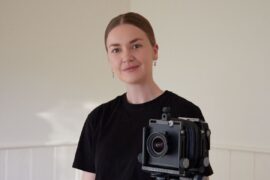Purposefully designed by The Afternaut, the rejuvenated Choa Chu Kang Public Library is more than a place to read and borrow books with various thoughtfully designed experiential zones for active learning.

December 27th, 2022
Littered throughout Singapore, public libraries appeal to various demographics from mugging students to avid readers and the retired elderly thumbing through newspapers in the morning. Often conveniently located at the hub of a district, they offer a quiet place for respite amid a bustling heartland.
One of the earliest public libraries to be situated within a mall, Lot One, the Choa Chu Kang Public Library – originally opened in 1997 – was revamped late last year. Led by the purpose-driven multidisciplinary design agency The Afternaut, the new library is guided by values of discovery, education and sharing. More than just a place for books, it comprises the mandatory functional zones alongside experiential features such as a living hydroponics lab to learn and observe crops and an augmented reality (AR) trail intuitively incorporated within bookshelves to promote active learning.

“Beyond simply designing spaces within the library to accommodate for new activities, an overarching experiential narrative was crafted to transform Choa Chu Kang Public Library from a place of passive learning to active knowledge acquisition,” says Gwen Tan of The Afternaut.
With a 30 per cent floor plan increase from 2,320 square metres to 3,017 square metres, the library now serves approximately 190,000 residents from across all walks of life. The Afternaut defined the characteristics of the users as “curious, independent and on-the-go”. As such, the inviting Library was deliberately kept open and inclusive with no barriers to entry from the main circulation network of the mall.

Drawing from the heritage of Choa Chu Kang, historically a gambier, pepper, rubber and fruit plantation, the new library invites the community to reconnect with nature through environmental, farming and sustainability narratives within the built environment. With a new rooftop extension, an indoor garden was introduced, leading the designers to adapt the nature-inspired concept cohesively throughout the library, serving as way-finding cues while promoting a sense of wellness.
Stepping into the library, users are faced with curvilinear shelves comprising an AR trail, a spiral book display that acts as a noise buffer from the mall and organic forms and fluid lines calling to mind the adventurous spirit of discovery – much like reading a book from cover to cover. The Children’s Library on the rooftop houses larger-than-life crops and insect installations to provoke a sense of curiosity and wonder. As a decorative element, bubble terrariums inspired by dandelions are randomly littered among shelves.

The library zones were named and aesthetically inspired by a natural environment: The Valley (Reading Area), The Cove (Programme Spaces), The Forest (Study Areas), The Meadows (Book Collection) and more. For example, The Forest where adults work or students study emulates the experience of being amongst flora and fauna with bespoke lighting, air plants and backlit silhouettes of lush greenery that lend a calming and tranquil effect for a conducive environment despite the lack of natural light within the space.
Tailoring to the needs of different user groups, the library also comprises a variety of seating options from sunken zones with cosy sofas to the quiet reading area that encourages sitting on the floor and small reading alcoves for lone readers. Programme spaces include two seminar rooms that can be merged into one large space through retractable acoustic partitions for flexible usage, catering to the different types of events that take place in the library.
A Community Wall was introduced, telling historical and current stories that showcase the transformation of Choa Chu Kang from traditional farming to new-generation high-tech farms, where visitors can contribute their memories. Going beyond the traditional role of the library to promote information literacy, the refreshed library cultivates a sense of belonging and a close-knitted community through thoughtful spatial design.



Client: National Library Board, Singapore
Location: Lot One Shopping Mall, Singapore
Designer: The Afternaut
Project Architecture: Formwerkz Architects
Project Team: Gwen Tan, Kokyong Chew
Completion Date: August 2021
Total Floor Area: 3,600 sqm
A searchable and comprehensive guide for specifying leading products and their suppliers
Keep up to date with the latest and greatest from our industry BFF's!

Schneider Electric’s new range are making bulky outlets a thing of the past with the new UNICA X collection.

In design, the concept of absence is particularly powerful – it’s the abundant potential of deliberate non-presence that amplifies the impact of what is. And it is this realm of sophisticated subtraction that Gaggenau’s Dishwasher 400 Series so generously – and quietly – occupies.

Within the intimate confines of compact living, where space is at a premium, efficiency is critical and dining out often trumps home cooking, Gaggenau’s 400 Series Culinary Drawer proves that limited space can, in fact, unlock unlimited culinary possibilities.

The Melbourne-based interior decorator mixes vintage pieces with botanical accents in Capella Singapore’s most exclusive dwellings.

Aunty Agnes Shea High School acknowledges historical connections to Country while providing a framework for future generations to engage with First Nations knowledge and traditions.
The internet never sleeps! Here's the stuff you might have missed

The latest stunning collection from Tappeti Fine Hand-Crafted Rugs + Carpets demonstrates the alchemical talents of designers and artisans in translating the world of nature into luxurious artefacts for human spaces.

Architectural photographer Tasha Tylee has been announced as this year’s winner of the Powerhouse Photography Architectural Commission and plans to document sustainable building practices and natural materials.

Eller brings human-centric design to the forefront, combining adaptability, ergonomics, and refined aesthetics to transform the modern workplace.

Renowned architect Madeleine Blanchfield shares insights into her design philosophy, her journey into architecture, and the award-winning project, Vessel. As the founder of Madeleine Blanchfield Architects, she discusses the challenges and triumphs of working with heritage buildings and creating homes that adapt to their owners’ evolving needs.